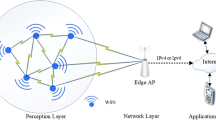Abstract
With the rapid development of Internet of Things, massive mobile intelligent terminals are ready to access edge servers for real-time data calculation and interaction. However, the risk of private data leakage follows simultaneously. As the administrator of all intelligent terminals in a region, the edge server needs to clarify the ability of the managed intelligent terminals to defend against malicious attacks. Therefore, the security level classification for mobile intelligent terminals before accessing the network is indispensable. In this paper, we firstly propose a safety assessment method to detect the weakness of mobile intelligent terminals. Secondly, we match the evaluation results to the security level. Finally, a scheme of security level classification for mobile intelligent terminals based on Adaboost algorithm is proposed. The experimental results demonstrate that compared to a baseline that statistically calculates the security level, the proposed method can complete the security level classification with lower latency and high accuracy when massive mobile intelligent terminals access the network at the same time.













Similar content being viewed by others
References
Kim J, Jeon Y, Kim H (2016) The intelligent IoT common service platform architecture and service implementation. J Supercomput 74(9):4242–4260
Boubiche DE (2018) Advanced industrial wireless sensor networks and intelligent IoT. IEEE Commun Mag 56(2):14–15
Dai W, Qiu M, Qiu L et al (2017) Who moved my data? Privacy protection in smartphones. IEEE Commun Mag 55(1):20–25
Lee YK, Kim JN, Lim KS et al (2017) Secure mobile device structure for trust IoT. J Supercomput 2017(7):1–19
Islam N, Das S, Chen Y (2017) On-device mobile phone security exploits machine learning. IEEE Pervasive Comput 16(2):92–96
Kraijak S, Tuwanut P (2015) A survey on IoT architectures, protocols, applications, security, privacy, real-world implementation and future trends. In: Proceedings of the WiCOM’15, pp 1–6
Shi W, Cao J, Zhang Q et al (2016) Edge computing: vision and challenges. IEEE Internet Things J 3(5):637–646
Taleb T, Dutta S, Ksentini A et al (2017) Mobile edge computing potential in making cities smarter. IEEE Commun Mag 55(3):38–43
Wang J, Hong Z, Zhang Y et al (2018) Enabling security-enhanced attestation with intel SGX for remote terminal and IoT. IEEE Trans Comput Aided Des Integr Circuits Syst 37(1):88–96
Galdi C, Nappi M, Dugelay J et al (2018) Exploring new authentication protocols for sensitive data protection on smartphones. IEEE Commun Mag 56(1):136–142
Park KC, Shin DH (2017) Security assessment framework for IoT service. Telecommun Syst 64(1):193–209
Lee L, Chen C (2016) The power of Smartphones. Multimed Syst 21(1):87–101
Wang G, Song Q, Zhu X (2015) An improved data characterization method and its application in classification algorithm recommendation. Appl Intell 43(4):892–912
Jia Q, Guo L, Jin Z et al (2016) Privacy-preserving data classification and similarity evaluation for distributed systems. In: Proceedings of the ICDCS’16, pp 690–699
Cavalcanti K, Viana E, Lins F (2017) An integrated solution for the improvement of the mobile devices security based on the android platform. IEEE Lat Am Trans 15(11):2171–2176
Irwan D, Asnar Y, Hendradjaya B (2015) Confidentiality and privacy information security risk assessment for Android-based mobile devices. In: Proceedings of the ICoDSE’15, pp 1–6
Dong Z, Wu Y, Pei M et al (2015) Vehicle type classification using a semisupervised convolutional neural network. IEEE Trans Intell Transp Syst 16(4):2247–2256
Deng Y, Ren Z, Kong Y et al (2017) A hierarchical fused fuzzy deep neural network for data classification. IEEE Trans Fuzzy Syst 25(4):1006–1012
Guo Y, Jia X, Paull D (2018) Effective sequential classifier training for SVM-based multitemporal remote sensing image classification. IEEE Trans Image Process 27(6):3036–3048
Ding X, Jiang T, Zou W (2017) A new method of dynamic gesture recognition using Wi-Fi signals based on Adaboost. In: Proceedings of the ISCIT’17, pp 1–5
Jiang D, Wang W, Shi L et al (2018) A compressive sensing-based approach to end-to-end network traffic reconstruction. IEEE Trans Netw Sci Eng 5(3):1–12
Jiang D, Huo L, Song H (2018) Rethinking behaviors and activities of base stations in mobile cellular networks based on big data analysis. IEEE Trans Netw Sci Eng 1(1):1–12
Jiang D, Huo L, Li Y (2018) Fine-granularity inference and estimations to network traffic for SDN. PLoS ONE 13(5):1–23
Jiang D, Huo L, Lv Z et al (2018) A joint multi-criteria utility-based network selection approach for vehicle-to-infrastructure networking. IEEE Trans Intell Transp Syst 19(10):3305–3319
Acknowledgements
This work was supported by National Natural Science Foundation of China (No. 61571104), Sichuan Science and Technology Program (No. 2018JY0539), Key projects of the Sichuan Provincial Education Department (No. 18ZA0219), Fundamental Research Funds for the Central Universities (No. ZYGX2017KYQD170) and Innovation Funding (No. 2018510007000134). The authors wish to thank the reviewers for their helpful comments. Dr. Dingde Jiang and Dr. Hong Wen are corresponding authors of this paper.
Author information
Authors and Affiliations
Corresponding author
Additional information
Publisher's Note
Springer Nature remains neutral with regard to jurisdictional claims in published maps and institutional affiliations.
Rights and permissions
About this article
Cite this article
Wang, F., Jiang, D., Wen, H. et al. Adaboost-based security level classification of mobile intelligent terminals. J Supercomput 75, 7460–7478 (2019). https://doi.org/10.1007/s11227-019-02954-y
Published:
Issue Date:
DOI: https://doi.org/10.1007/s11227-019-02954-y




